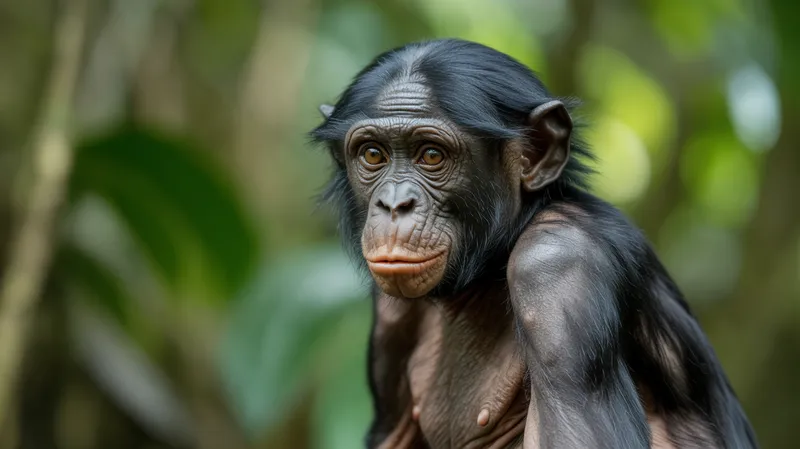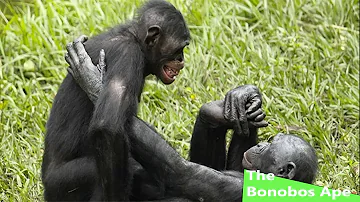
Bonobo
Pan paniscus

Meet the Bonobo
The bonobo is a highly intelligent and social great ape native to the dense lowland rainforests of the Democratic Republic of the Congo. Bonobos are known for their matriarchal societies, peaceful social interactions, and intricate forms of communication. They are closely related to chimpanzees, sharing about 98.7% of their DNA with humans, but differ in their more cooperative and less aggressive behaviors. Bonobos are arboreal and terrestrial, spending time both in trees and on the forest floor, and are recognized for their strong sense of empathy and complex social bonding.
Classification
Mammal
Habitat
Tropical lowland rainforest
Diet
Omnivore
Lifespan
35-40 years in the wild
Conservation
Endangered
Weight
30-45 kg
📖Fascinating Facts
Closest Human Relatives
Bonobos and chimpanzees are equally the closest living relatives to humans, sharing approximately 98.7% of our DNA.
Arboreal Lifestyle
Bonobos are highly agile and spend a significant amount of time in trees, where they forage for fruit, leaves, and small animals.
Matriarchal Society
Female bonobos form strong alliances and often lead their social groups, influencing group decisions and maintaining peace.
📋Detailed Description
The bonobo (Pan paniscus) is a slender, long-limbed great ape with a black face, pink lips, and prominent brow ridges. Adults typically stand 70–83 cm tall when upright and weigh between 30–45 kg, with females generally smaller than males. Their hair is black and parted down the middle of the head, and they possess relatively long legs compared to common chimpanzees (Pan troglodytes), giving them a more upright posture. Bonobos are highly arboreal, using their long fingers and opposable thumbs for climbing and foraging in the dense rainforests of the Congo Basin. Socially, bonobos live in large, fluid communities of 30–80 individuals, characterized by strong female alliances and matriarchal leadership. Their societies are notable for high levels of affiliative behavior, including frequent sociosexual interactions used for conflict resolution, bonding, and tension reduction. Communication is complex, involving a wide range of vocalizations, gestures, and facial expressions. Bonobos are omnivorous, feeding on fruit, leaves, seeds, flowers, and occasionally small vertebrates or invertebrates. Reproduction is non-seasonal, and females exhibit prominent sexual swellings signaling fertility. Bonobos are distinguished by their peaceful, cooperative social structure, high empathy, and capacity for tool use and cultural transmission.
💡 Did you know?
Bonobos are the only great apes that do not kill members of their own species in the wild.
🔬Research & Sources
Wikipedia Summary
The bonobo, also historically called the pygmy chimpanzee, is an endangered great ape and one of the two species making up the genus Pan. While bonobos are, today, recognized as a distinct species in their own right, they were initially thought to be a subspecies of Pan troglodytes, because of the physical similarities between the two species. Taxonomically, members of the chimpanzee/bonobo subtribe Panina—composed entirely by the genus Pan—are collectively termed panins.
Last Modified: 6/11/2025
🎭Behavior & Social Structure
Bonobos exhibit diurnal activity patterns, with most foraging and social interactions occurring during daylight hours. Their diet is primarily frugivorous, with fruit constituting up to 60% of intake, supplemented by leaves, pith, seeds, flowers, fungi, and small animals such as insects, earthworms, and occasionally duikers or flying squirrels. Unlike chimpanzees, bonobos rarely engage in organized hunting or meat-sharing. Social interactions are marked by frequent grooming, play, and sociosexual behaviors that serve to reinforce group cohesion and reduce aggression. Females form strong coalitions that can dominate males, and disputes are often resolved through sexual contact rather than violence. Bonobos travel in subgroups that change composition throughout the day (fission-fusion dynamics), and sleeping nests are constructed in trees each night. Tool use is observed but less frequent than in chimpanzees, with occasional use of leaves for drinking or sticks for foraging.
👶Reproduction & Life Cycle
Bonobos are polygynandrous, with both sexes mating with multiple partners. Sexual activity is not restricted to reproduction and occurs throughout the female's estrous cycle, serving social functions. The gestation period is approximately 240 days (about 8 months). Females give birth to a single infant, rarely twins, at intervals of 4–6 years. Infants are highly dependent, clinging to their mothers for the first 6 months and nursing for up to 4 years. Maternal care is extensive, and mothers play a central role in social integration and protection of offspring. There is no defined breeding season, and sexual swellings signal ovulation. Males remain in their natal groups, while females typically disperse at adolescence (around 7–9 years).
🛡️Adaptations & Survival
Bonobos possess several adaptations for an arboreal and terrestrial lifestyle, including long, flexible limbs for climbing and knuckle-walking. Their extended social and sexual behaviors are evolutionary adaptations for reducing intra-group aggression and fostering cooperation. The matriarchal social structure, with strong female alliances, is unique among great apes and may be an adaptation to resource distribution and predation risk in the Congo Basin. Anatomically, bonobos have a relatively small face, reduced canine dimorphism, and a more gracile build compared to chimpanzees. Cognitively, they demonstrate advanced problem-solving, empathy, and the ability to understand symbolic communication.
🎨Cultural Significance
Bonobos are less prominent in traditional African folklore than chimpanzees or gorillas, partly due to their restricted range. However, they have gained international attention as symbols of peace, empathy, and matriarchal society, often contrasted with the more aggressive chimpanzee. In modern culture, bonobos are featured in documentaries, conservation campaigns, and scientific discussions about human evolution, sexuality, and social behavior. Their gentle nature and intelligence have made them important ambassadors for great ape conservation.
🔬Recent Research & Discoveries
Recent research has highlighted bonobos' advanced cognitive abilities, including understanding of cooperation, empathy, and even rudimentary forms of culture and tool use. Studies using captive populations have demonstrated their capacity for symbolic language, delayed gratification, and complex problem-solving. Field studies have revealed unique social strategies, such as female coalitions and food sharing, that differ markedly from chimpanzees. Ongoing research focuses on genomics, disease susceptibility, and the impact of environmental change on bonobo populations. Conservation genetics is a growing field, aiming to understand population structure and maintain genetic diversity.
🎥Wildlife Videos

Rainforest Queens: Bonobo Survival (Full Episode) | Queens
The Congo Forest in Central Africa is home to a secretive animal we still know very little about. Bonobos are one of our closest ...
National Geographic

The Bonobos Ape (Nature Documentary)
TheAnimalPortal #Animaldocumentary #Wildlife #Nature.
TheAnimalPortal

Bonobos: Back to the Wild
The plight of the endangered BONOBOS of Africa - mankind's closest genetic relative - are presented in this critically praised, epic ...
Best Documentary

The Secret Culture of the Apes | Free Documentary Nature
The Secret Culture of the Apes | Wildlife Documentary Watch 'Go Ape - The Fascinating World of Primates' here: ...
Free Documentary - Nature

Bonobos | 60 Minutes Archive
Bonobos, our primate cousins, are an endangered species, live in female-dominated groups and would rather make love than war ...
60 Minutes

Things You Probably Didn't Know About Cute Bonobos | National Geographic
Bonobos are the only ape that doesn't kill. And unlike any other ape, bonobos help each other out (a lot like humans do). Through ...
National Geographic
🌍Habitat Information
The Bonobo typically inhabits Tropical lowland rainforest environments. Bonobos have adapted to their environments with specialized features and behaviors.
Primary Habitat:
Tropical lowland rainforest
More detailed habitat information will be available soon.
🛡️Conservation Status
The Bonobo is currently classified as Endangered. Conservation efforts are crucial for preserving this species for future generations.
Common Threats:
- 🏠Habitat loss and fragmentation
- 🌡️Climate change impacts
- 🎯Hunting and poaching
- 🏭Human-wildlife conflict
⚠️Threats & Conservation Challenges
Bonobos face severe threats from habitat loss due to logging, agriculture, and mining in the Democratic Republic of the Congo. They are also hunted for bushmeat, and civil unrest in the region exacerbates poaching and habitat destruction. Disease outbreaks, including Ebola, pose additional risks. The total wild population is estimated at 15,000–20,000 individuals, with a declining trend. Conservation is hindered by political instability, limited protected areas, and lack of effective law enforcement. Fragmentation of populations increases vulnerability to genetic bottlenecks and local extinctions.
🔬Scientific Classification
Scientific Name
Pan paniscus
Classification Hierarchy
🔍 About Taxonomic Classification
Taxonomic classification is a hierarchical system used by scientists to classify and organize living organisms based on shared characteristics and evolutionary relationships.
The system moves from broad categories (Kingdom) to increasingly specific ones, with each animal's scientific name typically consisting of its Genus and species.
📝Community Notes
Share your observations and insights about the Bonobo with our community of wildlife enthusiasts.
Join Our Community
Sign in to share your observations and connect with fellow wildlife enthusiasts.
Sign In to ContributeNo community notes yet
Be the first to share your observations about the Bonobo!
Explore Bonobo
Select a tab above to learn more about this amazing animal.
📸Photo Gallery
No photos available for this animal yet.
🌟Discover More Wildlife
Continue your journey of discovery with more fascinating animals from our database
